01/20/2020 – My area is populated by gentleman farmer/ranchers. The term “Gentleman farmer/rancher”, in my vernacular, means they all have day jobs, but buy only commercial size and grade equipment that never leaves their property. The neighbor across the road put $34,000 into a new Ventrac 4500Z tractor with 4 wheel drive, enclosed heated cab, snow blower, V blade plow, drop spreader, and snow broom to clear his 40′ driveway. The adjacent neighbor put a a similar amount into a B series Kubota, to clear a 60′ driveway. Chuck and I became the neighborhood victims of tractor shaming, a recent rural development that is sharply on the rise.
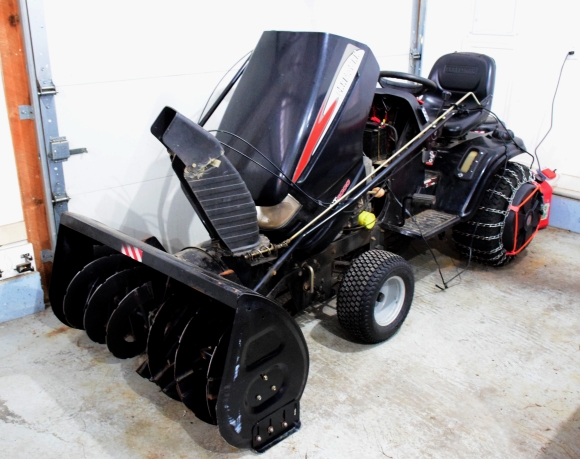
Chuck is my sixteen year old Sears GT5000, a Husqvarna built garden tractor. A $2500 purchase when new, it handles both warm weather landscaping and winter snow removal duties. No cab, no heater, no hydraulics. During the winter, the 725 cc twin engine’s 26 horse power push the 1,000 pounds of tractor, wheel and hitch weights behind a 48″ wide two stage snow blower. Low, low gearing and an automatic transaxle keep Chuck crawling along, clearing 100′ of driveway and 2,000 square feet of bump out and walkway space in less than an hour, even in the aftermath of Maine’s most severe snowstorms.
So there we were a week ago, at the street end of each of our respective driveways, snow plumes blowing high in the air, engines laboring under heavy loads, all machines dedicated to the mission, but the Ventrac and Kubota had something else, something so significant that I knew it was time for an upgrade. Atop each of the neighbors’ cabs was a rotating amber anti collision light, the same as would be seen on town and county road equipment, while Chuck had only dim headlights to mark his position in defense from roadway traffic.
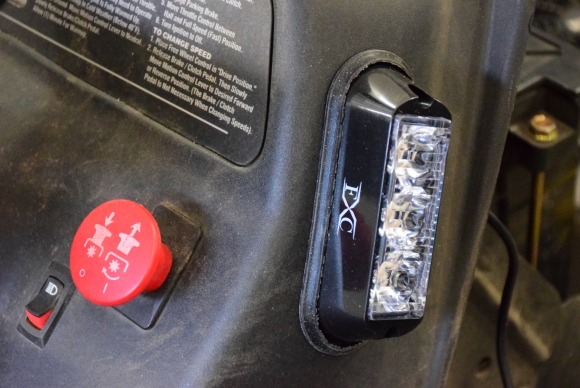
Sparing no expense, a $16 pair of 3-LED Amber Strobe, waterproof, caution lights were mounted on Chucks Cowl. But there is more, so much more. Each light has a choice of 12 selectable flashing patterns, or they will automatically cycle through all. And, AND, I now have three control switches on Chuck’s dashboard, one on/off, and two momentary interrupt switches that permit each light’s sequences to be changed on the fly! We made a run last night and Chuck was throwing snow like never before. No, I don’t think this will close the $30,000 gap with the other tractors. That will come this weekend when I install a $25 pair of 240 watt LED spot/flood lights with even more dash board switches. Oh, sorry. The article…
The challenges of winter shooting
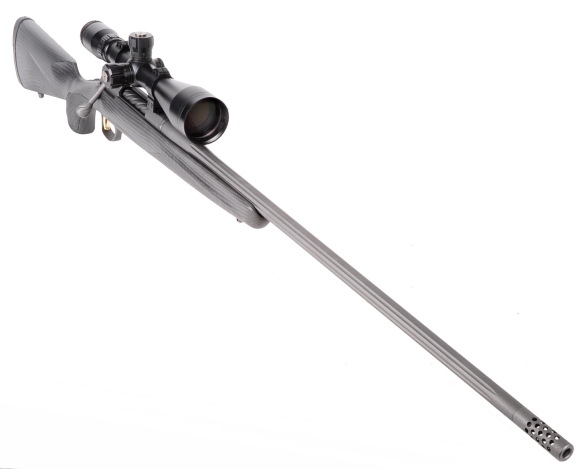
The Browning X-Bolt Pro Tungsten has too many things going for it to not give it a good run with handloads. All that was necessary to conclude that part of this project was to shoot with ambient temperature at a non-chill factored 5°F and then trudge through snow to put up and change targets. I know, do I want a medal or a chest to pin it on? Both, please.
The biggest concern during the process was keeping firearm and ammunition 50°F to minimize the effects of some of the powder types that are temperature sensitive. So the rifle and ammo was kept indoors, a magazine was loaded, then it was all hauled outside and shot over the chronograph or down range at targets. Rifle and ammunition temperatures were monitored with an infrared thermometer and brought indoors for warmup as required. Mostly, cool down was the result of taking too much time to log data or to retrieve targets as shooting the 7mm Remington Magnum cartridge tended to keep both gun and ammo… toasty.
The 7mm Remington Magnum Cartridge
In the late 50s, and through the early 60s, it was common for companies like Winchester and Remington to shorten the 375 H&H to 30-06 Springfield length, lose most of the cartridge body taper, sharpen the shoulders, and neck them down or up to suit a wide range of calibers. Some of the more specialized derivative cartridges served niche markets and mostly faded away, but some persist in popularity even today. For Winchester, the iconic standard length belted magnums might be the 300 Winchester Magnum and the 338 Winchester Magnum. For Remington, it is definitely the 7mm Remington Magnum. L-R below: 375 H&H, 264 Win Mag, 7mm Rem Mag, 300 Win Mag, 338 Win Mag, 458 Win Mag.
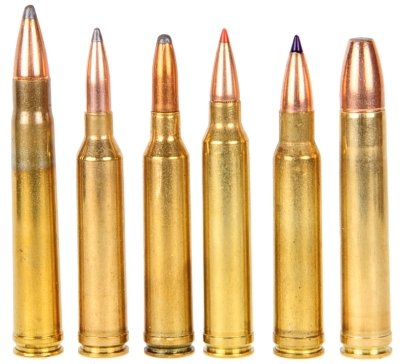
The belt on the case represents neither good or evil, although it has outlived its purpose. Sort of like the vestigial auricularis muscle groups found in humans that once permitted fluid ear movement upward and forward to directionally capture sound. Twenty percent of the population can still wiggle their ears with varying degrees of control, while the other non-practitioners of the art can only look on with envy.
The belt replaced the use of a case rim to work reliably with magazine fed, bolt action rifles that came into prominence in the early 1900s. During those days of less than precise machine tools and machining, and cartridges with long sloping shoulders, the belt also provided a sure surface for headspace control. Yes, we are drifting into outer space and far away from the subject at hand.
As a selection for the Browning X-Bolt Pro Tungsten with 26″ barrel, even with eleven alternative cartridges from 6.5 Creedmoor to 300 Remington Ultra Magnum, the 7mm Remington Magnum is an excellent choice. It is flat shooting, powerful and adaptable to a wide variety of game and hunting conditions. While it possesses the intensity of other belted magnums, recoil is not as bad as the bigger bores, but it can handle any North American game.
In terms of bore longevity, the 7mm Remington Magnum rates a 17.6 on the Real Guns Barrel Burner Index. By comparison, the 300 WSM scores 16.8 and the 257 Weatherby Mag a 20.9. In reality, much of barrel life is determined by how the rifle is shot and how it is maintained. My personal 7mm Rem Mag is 40+ years old and it is used only for proficiency shooting and hunting. I keep it clean, I don’t shoot it until the barrel glows red and it sees on the average 60 rounds of ammo each year. It still shoots MOA to sub MOA.
Browning X-Bolt Handloads
Prices for factory ammunition are pretty much all over the place within the population of sixty-seven 7mm Remington Magnum loads, a composite of fifteen brands. When I say they are all over the place, that means price setting is devoid of logic attributed to tangible features and benefits. Twenty rounds from premium brand suppliers can range in price from $25 to $75, with virtually no ballistic differences.
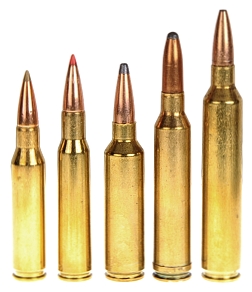 My preference is to handload for optimal accuracy for each cartridge. This allows me to maintain a generic inventory of bullets by caliber and use them as suits the circumstances, rather than maintain a much larger and more expensive inventory of factory ammunition.
My preference is to handload for optimal accuracy for each cartridge. This allows me to maintain a generic inventory of bullets by caliber and use them as suits the circumstances, rather than maintain a much larger and more expensive inventory of factory ammunition.
The six bullets selected for the Browning X-Bolt project have been used successfully in most of the other 7mm rounds handloaded in the shop, some of which are pictured L-R: 7mm-08 Rem, 7x57mm Mauser, 7mm WSM, 7mm Rem Mag, 7mm Rem Ultra Mag.
I am not sure who began the rumor that money can’t be saved by handloading, but I would guess it was someone who shoots bargain basement 223 Rem type cartridges. A twenty count box of premium 7mm Remington Magnum handloads cost approximately $12, amortizing the cost of brass over nine reloads.
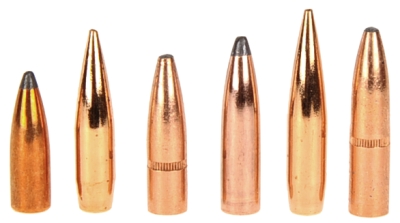
Six bullets were selected for the Browning X-Bolt Pro Tungsten handload effort. All are hunting bullets, if perhaps optimal at different ranges and velocity levels. In my experience, I can take the scope off of my 7mm Rem Mag and hunt inside 100 yards with all but the two Berger VLD bullets. Those I would reserve for longer range hunting as they will rapidly expand in game at even 1,500 fps and longer ranges are where a very low drag very high ballistic coefficient bullet are most useful.
Warning: Bullet selections are specific, and loads are not valid with substitutions of different bullets of the same weight. Variations in bullet length will alter net case capacity, pressure and velocity. Primer selection is specific and primer types are not interchangeable. These are maximum loads in my firearms and may be excessive in others. All loads should be reduced by 5% as a starting point for development where cartridges have greater than 40 grains in capacity and 10% for cartridges with less than 40 grain capacity following safe handloading practices as represented in established mainstream reloading manuals. Presentation of these loads does not constitute a solicitation for their use, nor a recommendation.
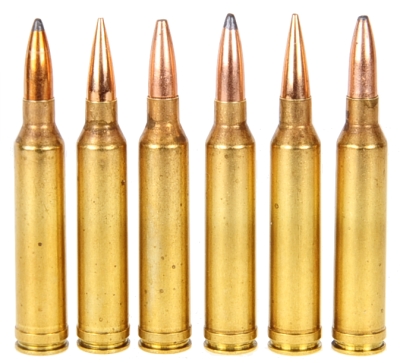
| 7mm Remington Magnum – MAP 61KPSI |
|
| Firearm | Browning X-Bolt Pro Tungsten |
| Barrel Length | 26.00″ |
| Max Case Length | 2.500″ +0.000″/-0.020″ |
| Min – Max COL | 3.150″ – 3.290″ |
| Primer | CCI 250 (LRM) |
| Bullet Diameter | 0.2845″ +0.000″/-0.0030″ |
| Reloading Dies | RCBS |
| Bullet Type | Bullet Weight Grains |
Net H2O Grains Capacity |
COL” | Powder Type | Powder Charge Grains |
Muzzle Velocity fps |
Muzzle Energy ft/lbs |
100 Yard 3 Shot Group” |
| Sierra Pro Hunter | 120 | 78.7 | 3.250 | AA MagPro | 77.0 | 3420 | 3117 | 0.9 |
| Sierra Pro Hunter | 120 | 78.7 | 3.250 | Re 16 | 65.0 | 3440 | 3154 | 0.6 |
| Sierra Pro Hunter | 120 | 78.7 | 3.250 | Hybrid 100V | 66.0 | 3381 | 3047 | 0.8 |
| Berger VLD Hunting | 140 | 74.5 | 3.250 | AA MagPro | 73.0 | 3292 | 3370 | 0.9 |
| Berger VLD Hunter | 140 | 74.5 | 3.250 | Re 23 | 68.0 | 3297 | 3380 | 0.4 |
| Berger VLD Hunter | 140 | 74.5 | 3.250 | Norma MRP | 70.0 | 3299 | 3384 | 0.6 |
| Remington PSP | 140 | 76.4 | 3.225 | AA MagPro | 73.0 | 3115 | 3017 | 0.8 |
| Remington PSP | 140 | 76.4 | 3.225 | Re 23 | 69.0 | 3347 | 3483 | 0.4 |
| Remington PSP | 140 | 76.4 | 3.225 | Norma MRP | 70.0 | 3292 | 3370 | 0.6 |
| Speer Spitzer SP | 160 | 75.0 | 3.280 | AA MagPro | 71.0 | 3111 | 3439 | 1.0 |
| Speer Spitzer SP | 160 | 75.0 | 3.280 | Re 33 | 79.5C | 3147 | 3519 | 0.8 |
| Speer Spitzer SP | 160 | 75.0 | 3.280 | Norma MRP | 68.0 | 3078 | 3367 | 0.5 |
| Berger VLD Hunter | 168 | 72.8 | 3.280 | AA MagPro | 69.0 | 2864 | 3061 | 0.8 |
| Berger VLD Hunter | 168 | 72.8 | 3.280 | Re 23 | 68.0 | 3183 | 3780 | 0.5 |
| Berger VLD Hunter | 168 | 72.8 | 3.280 | Norma MRP | 68.0 | 3045 | 3460 | 0.5 |
| Remington PSP Core-Lokt | 175 | 73.4 | 3.250 | AA MagPro | 69.0 | 2807 | 3063 | 0.9 |
| Remington PSP Core-Lokt | 175 | 73.4 | 3.250 | Re 25 | 67.5 | 2822 | 3095 | 0.4 |
| Remington PSP Core-Lokt | 175 | 73.4 | 3.250 | Norma 217 | 72.0 | 2960 | 3405 | 0.6 |
| Remington PSP Core-Lokt | 175 |
73.4 | 3.250 | H870 |
77.0 |
2901 |
3271 | 0.9 |
| Remington PSP Core-Lokt | 175 |
73.4 | 3.250 | Retumbo |
73.0 |
3136 |
3822 | 1.1 |
There is nothing unique about handloading the 7mm Remington Magnum, other than the cartridge case. Only one load was compressed, care taken is no different than any other handload. Cases were uniformly trimmed to 2.485″ after full length sizing of new brass, bullets were retained by case neck tension alone.
No excessive case stretch above the case belt, no excessively flat or popped primers, no hard extractions. Some loads were under anticipated velocity, some considerably over, but they are all at my limit for powder charges. Why would I stop at a lower than anticipated velocity without signs of excessive pressure? Because pushing above some of the loads resulted in no gain of significance and flat pressure in the face of increased charges is often followed with a pressure spike. So why push a charge if there is no benefit and run the risk of hitting high or erratic pressure levels? Better to select a more appropriate powder.
I think the 26″ barrel is definitely a plus, particularly at heavier bullet weights, delivering numbers I can’t hit with my 24″ barrel 7mm Rem Mag. What do these handloads play out over the long haul?
| Best Zero Results – 168 grain Berger | |||||||
| Near-Zero – yds. | 29 | Mid Range – yds. | 154 | ||||
| Far-Zero – yds. | 274 | Max Ordinate – in. | +3.0 | ||||
| Point Blank – yds. | 292 | ||||||
| Best Zero : Range 0 – 500 yards | ||||||||||||
| Yards | 0 | 50 | 100 | 150 | 200 | 250 | 300 | 350 | 400 | 450 | 500 | |
| Velocity – fps | 3183 | 3105 | 3028 | 2953 | 2879 | 2805 | 2733 | 2662 | 2593 | 2524 | 2456 | |
| Energy – ft.-lbs. | 3779 | 3595 | 3420 | 3252 | 3091 | 2935 | 2787 | 2644 | 2507 | 2376 | 2250 | |
| Momentum – lbs-sec | 76 | 75 | 73 | 71 | 69 | 67 | 66 | 64 | 62 | 61 | 59 | |
| Path – in. | -1.50 | 0.91 | 2.43 | 2.99 | 2.56 | 1.08 | -1.50 | -5.25 | -10.22 | -16.49 | -24.12 | |
| Drift – in. | 0.00 | 0.00 | 0.00 | 0.00 | 0.00 | 0.00 | 0.00 | 0.00 | 0.00 | 0.00 | 0.00 | |
| Time Of Flight – sec. | 0.00 | 0.05 | 0.10 | 0.15 | 0.20 | 0.25 | 0.31 | 0.36 | 0.42 | 0.48 | 0.54 | |
Essentially, the 168 Grain Berger load can cover nearly 300 yards without rising or dropping more than 3″ over line of sight and at 500 yards the bullet is still traveling 2,456 fps.
Conclusion
I found the Browning X-Bolt Pro Tungsten to be exceptionally accurate, especially considering this is a 6 lb 10 oz firearm that was shot in 5°F Maine weather. The action remained slick throughout periods of shooting. The trigger, left as received from the factory remained light in pull and free of creep. The X-Lock scope fastener scheme held up to the load of a hefty 4.5-30x scope used for shooting groups. When the shooting was done, the bore wiped clean and the rest of the rifle looked as good as received.
The Browning X-Bolt Pro Tungsten is what people have come to expect from Browning, a terrific firearm that is more than a cut above the rest.
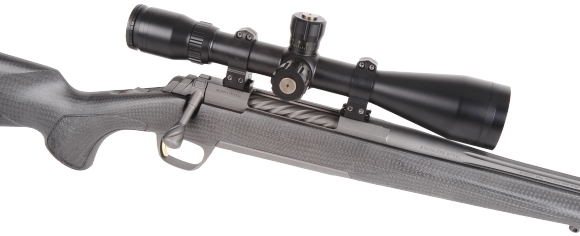

Email Notification